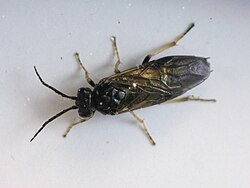| Nematinae | |
|---|---|
 | |
| Hemichroa australis | |
| Scientific classification | |
| Domain: | Eukaryota |
| Kingdom: | Animalia |
| Phylum: | Arthropoda |
| Class: | Insecta |
| Order: | Hymenoptera |
| Suborder: | Symphyta |
| Superfamily: | Tenthredinoidea |
| Family: | Tenthredinidae |
| Subfamily: | Nematinae |


Nematinae is a subfamily of sawflies belonging to the family Tenthredinidae. It contains over 1250 described species in ~40 genera. Members of this subfamily feed on a wide range of plants (over twenty plant families have been recorded as hosts) and employ a wide range of feeding habits, both internally and externally, on their host plants.
Contents
Most groups of insects tend to have maximum numbers of species in the tropics and decrease towards the poles. The Nematinae reverse this trend, with the highest number probably occurring in the boreal forest zone. The reason is not fully understood but could be because of the abundance of species of willow (Salix species) in the region. [1] In 2014, species feeding on willow, in the genera Eupontania , Phyllocolpa , Pontania and Tubpontania , were placed in the genus Euura , reflecting advances in the understanding of their phylogeny. [2]